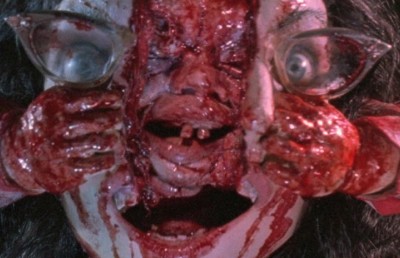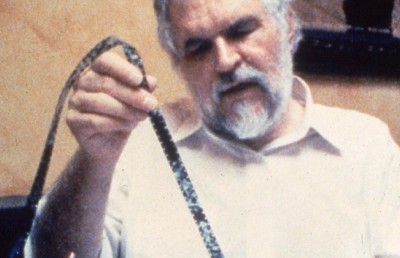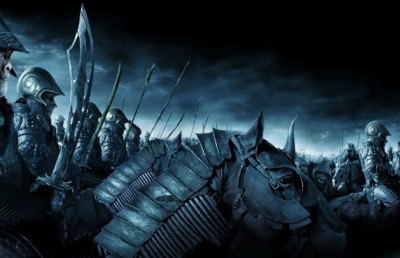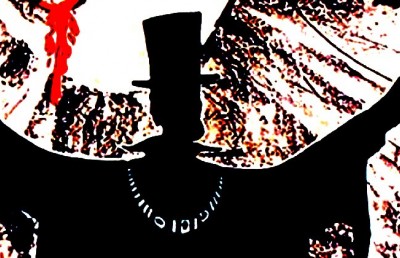Fantasia 2001 Report: Post 9/11
Reality-Based Violence
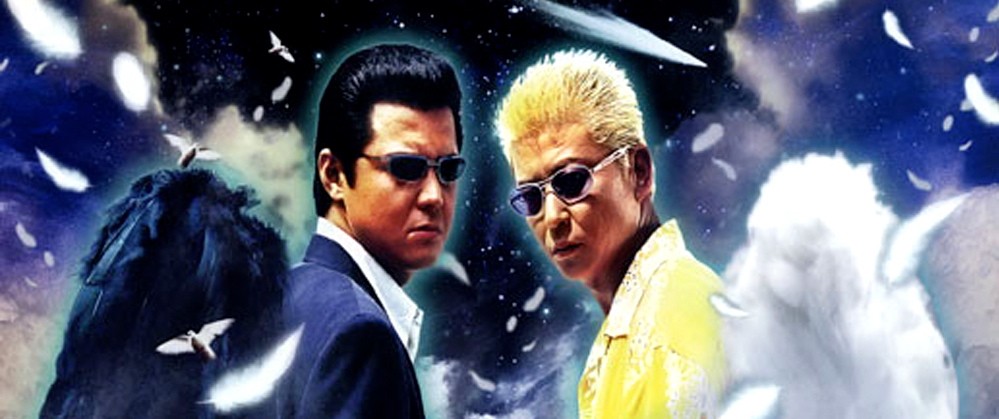
Well, it may come as a relief for some of you to hear that I am not going to start this report with any commentary on the events that have transpired in the US less than two weeks ago. However, I will end with a note on the subject, so for those as obsessed with the whole deal as I am you will be able to get yet another fix. I believe it is important to talk and think about what has happened, especially in the context of image and media culture. We live in a society that craves spectacle, and the Fantasia film festival is ground zero for many who can’t get enough intense imagery to fill the void. I count myself squarely among this crowd of insatiables, and I’ve lately been forced to ask myself why that is. For now, however, I intend to remain positive, for the second half of the festival was indeed very satisfying. So I begin with a look at the gems that graced the screen of the Imperial Cinema during the last week of July 2001.
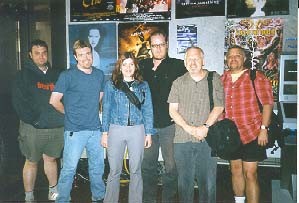
Fantasia Loyalists inside mecca Imperial
First up: the one I was waiting for. Not that I knew what it would be or in what form it would come, but whenever I go to festivals I’m always waiting for THE film that blows me away. I don’t always find it, although it seems to happen pleasantly often. I remember three years ago at the Vancouver International Film Festival, after a depressing run of mediocre films, I stumbled across Sombre by first-time French director Philippe Grandrieux, and I knew the festival was over. There were still a few days left to go, but there was no way anything was going to top that. And nothing did. Similarly, Fantasia 2000 yielded Uzumaki from Hungarian/Japanese prodigy Higuchinsky, also a festival stopper, and now easily one of my favorite films in any context. Nor will I soon forget last October’s Festival International de Nouveau Cinéma et Nouveau Média (FCMM) here in Montreal, where a little piece entitled The Goddess of 1967 by Clara Law ripped the roof off the top of my head and gave my squishy insides a good scrubbing (though let it be known that the Quay Brothers’ In Absentia also left me quivering and gasping both times I saw it, and Wong Kar-Wai’s In the Mood for Love will certainly not go unmentioned). Actually, there was a ton of good stuff at last years FCMM. But I digress.
This year’s Fantasia lock was, for me, Takashi Miike’s Dead or Alive 2: The Birds.After the absolute fury and total jaw-dropping absurdity of the finale to Dead or Alive as witnessed by last year’s Fantasia audience, I had no idea what Miike could possibly come up with as a sequel. As many will remember, after taking us on a ride through the very seedy nuances of gang warfare between the Chinese Mafia, Yakuza, and a cop who’d had enough of it all, Dead or Alive ends with a confrontation of historic proportions. *(Note to those who have not yet seen it and would like to: MASSIVE SPOILERS AHEAD). Pitting one bad-ass Yakuza against the aforementioned peace officer, the end of the film finds the two in a standoff. Having removed himself from the remains of a car that exploded with him inside, the Yakuza tears off his arm after noticing that it has been severely injured. Ready for action, he then produces a mammoth bazooka from behind his back (where it could not possibly have been hiding all this time). In response to this gesture the cop reaches into his breast pocket and reveals a glowing orb slightly otherworldly in nature. A moment passes, and then the bazooka is fired, the orb being promptly hurled in counterattack. Just before the two projectiles meet in mid-air, we are removed from the scene to a view of the Earth from space. Serene for a second, and then the whole thing just explodes. Complete annihilation. Fin.
So, with that image etched into the fibers of my brain tissue, Dead or Alive 2 opens with a shot of the Earth from space, a comet hanging peacefully over it in the blissful serenity of time standing in the stillness of cosmic grandeur. I sit patiently waiting for some recap of the destruction witnessed last year, but it is soon clear that we are not in store for a repeat of part one. The whole concept of the sequel is called into question here as over the next 96 minutes it is as if time has actually stopped somewhere in the moments just prior to the Armageddon of the film’s predecessor, treating us to a rare glimpse into the goings on between the moments that ordinarily pass in the blink of an eye.
Those seeking the all-out carnage of the first film might have been disappointed here, although Dead or Alive 2 did take first prize in the Fantasia audience awards for best Asian film. Here again the story revolves around the ongoing gang warfare between the Chinese mob and the Yakuza, and there is some excellently excessive brutality to appease the bloodthirsty. But this film also boasts a wonderful beauty and serenity that demonstrates the depth of Miike’s cinematic capabilities. In a nutshell, a hitman staking out his target is about to fulfill his contract when, through the viewfinder of his rifle, he witnesses a stranger taking care of the job for him. Feeling that he recognizes the stranger from his youth, he tracks the man down. It turns out that they were indeed childhood friends. Both now on the run from the mob, they retreat to the island where they grew up together and there commence a journey of rediscovery. Placing their current gangster activities in the context of their childhood innocence, either lost or still intact, they decide to make a change in their lives: continue with their contract killings, but put all the proceeds towards feeding the starving children of Africa. With that they descend upon Tokyo to carry out their mission of redemption. And their descent is literal, as their newfound righteousness is made materially manifest in the form of wings that they use to swoop down on their unsuspecting targets, feathers flurrying all about; hence the birds of the film’s subtitle.
The notion of killers in the midst of lost innocence and the seeking of redemption is certainly not new to the cinema, but there is so much more to The Birds than just that. Miike’s treatment of the material is exquisite in its combination of formal brilliance, rampant brutality, genuine sweetness, and pure hilarity. This film is not in the vain of other gangster comedies where the humour is vicious and black. Although laughter is indeed prompted by the sheer extremism of some of Miike’s tactics, there is also a real touch of grace evident in the director’s hand. Those who have seen The Bird People of China will recognize Miike’s softer side, a side that can also be seen in the first half of Audition and which is very apparent in large portions of The Birds.
While the killers are in retreat on their island of childhood memories, there is a real sense of peace as they reconnect with their roots. As they retrace the geography of their past experiences, Miike inserts shots of them as children playing and going about their daily activities. When juxtaposed with the men at their present age, a poignancy arises that opens a real depth of feeling for the characters that is further enhanced when the men start reliving those lost moments in the present. It is genuinely funny and touching to see the suited men, whom we know to be hardened criminals, hosing each other down with water, swinging in the park, and playing soccer.
There are strains of Takeshi Kitano in the combination of slightly melancholic piano music (very reminiscent of the work of Kitano’s composer Joe Hisaishi) and the interplay between childhood and adulthood that Miike explores here. Kitano’s Kikujiro is probably the best example of the type of intergenerational relations I see in at work in The Birds as well. But this is not to say that Miike is ripping Kitano off; there is something deeper here about Miike’s feeling for the subject matter that makes it stand on its own, regardless of the awareness he must have of Kitano’s worldwide influence on new interpretations of the Yakuza genre.
While on the island the two assassins, in conjunction with the friend at whose house they are staying, decide to mount a play for the local children complete with full costumes and sets. The play itself is hilarious, and the interaction between the children in the audience with the staged events is also very touching. The fact that this scene is intercut with the film’s most violent episode, a raging battle between warring gang factions back in the city (involving some horrendous acts of sheer vicious rage), does not put the play in a cynical light or create a disruptive tension between the two simultaneous happenings. Miike has a way of making both scenarios appreciable for what they are. While comparisons with the famous baptism/assassination sequence in Godfather II are justified, here the extremes of juxtaposition do not play to a high moral questioning of the events. Rather, the killers are placed in their proper context, and we can see how their loss of and reconnection to the concept of youth has resulted in their present state of hiding and their subsequent decision to take control of their fates. Miike’s frequent use of juxtaposition also plays into the inevitable comparisons that will be made between this film and its predecessor, placing each in the context of the other in order to try and perceive the larger picture.
The island segment also acts as the nucleus for the sense of timelessness that permeates the film, as the line between the killers’ current lives and their childhood lives is blurred to the point where the two become one. Their time on the island is a great lull in the flow of the work, as the violence that begins the film and carries on later leaves the viewer with a sense of impending confrontation that is at its peak while in the limbo of the killer’s retreat. This limbo is the stillness of the motionless comet made manifest in the lives of the people living below. The images of the comet actually provoke laughter from time to time; there is a slight cheesiness in the way that they are more akin to still photographs than to motion pictures which makes them appear to be a cheap solution to a lack of special effects funding. However, I believe that the stillness of the comet actually suggests the fact that the journey of our heroes does, in fact, occur in a kind of pre (or post) apocalyptic state of suspension.
This timelessness can also be felt as an almost supernatural presence that permeates the space of the film. The presence is suggested from the very beginning of the film as the theme of the birds that is illustrated from time to time as a rush of indistinguishable flying creatures streaking through the dense metropolis and on into the open sky. Later, when the killers begin their righteous mission and have sprouted wings of their own, the force that was loose in the world is now contained within them. This force also allows them to transcend the confines of bodily existence. Towards the end of the film our heroes are painted into a corner with their own blood as their enemies finally catch up to them and gun them down. At this point, however, they rise and return once again to their island, drenched in blood but assuring all whom they encounter along the way that they are, indeed, fine. Stopping in on their friend, they find that his wife has just given birth and the film ends with an image of the newborn child. The words “where are you” that have appeared periodically throughout the film now give way to the words “where are you going?” and the space that the film has occupied comes to an end and our lives are now free to continue. It is as though the destruction caused by violent confrontation at the end of part one is called into question here by a larger cosmic presence, bringing the world to a halt so that two men may pinpoint their own place within that world and its turmoil before moving on to become a part of the bigger picture. That bigger picture is where the film and its protagonists are going.
The journey to that bigger picture takes place within a space where time simultaneously operates in linear and non-linear fashion. The merging of the ideas of birth, childhood, adulthood, death and afterlife are treated here non-linearly, while the narrative itself proceeds logically. The narrative logic presents us first with the men as adults, then as children, then as angels of the afterlife, then finally as adults at the end of their lives who yield to the birth of the next generation. While Miike doesn’t play with our narrative perceptions through heavy montage games like he does at the end of Audition, there is still the effect of points in time folding in on one another as the two killers make their way through the otherworldly space of an Earth in a state of suspension.
Finally, it is the larger picture of the Earth’s simultaneous fragility and stoic presence that ends Dead or Alive and which begins The Birds. Along with the holistic approach to the cycle of life that The Birds presents with its simultaneous interest in childhood, adulthood, birth, life, death, and afterlife, the macrocosmic view of the Earth in both utter destruction and the peace of stillness works to illustrate the true flight of Miike’s ambition: the search for balance in chaos, peace in turmoil, and the illustration of the fundamental interconnectedness of all things. Takashi Miike is not relegated to the use of his thumb to make his way across the galaxy; his spirit soars with the effortlessness of a bird riding the currents of millennial cinema, breathing new life into it as he goes. Fitting that The Birds ends with the image of a newborn child. There is indeed hope for the future, and I gather Dead or Alive 3 will be out next year. I trust the Fantasia crew will ensure its placement in the 2002 lineup.
Another gem of Fantasia’s second half was Larry Fessenden’s Wendigo. This was easily one of the best films of the festival. Fessenden really comes alive here with a very strong intuitive sense of the power and magic of cinema. In the Q + A session the director acknowledged how much of the visual style he achieved in the film was a direct result of the particular technologies he was working with. This is a refreshing change from standard big studio fare that fights technological limitations and tries to hide them through a wide range of cover-up techniques. Wendigo falls much more readily into the realm of the American avant-garde that has long celebrated filmmaking practices that embrace the materiality of the medium. Revolving sparsely around the story of a family that travels to a small hunting town up north to spend a long weekend at a friend’s cabin, the possible supernatural presence that arises in the woods around the town is breathtakingly rendered with some very simple but effective techniques.
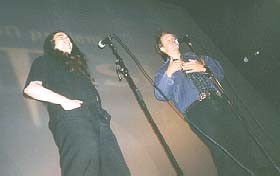
“Moderator Mitch” (left) with Larry Fessenden After Screening of Wendigo
Various incarnations of this Wendigo, a mythological half-man/half-deer, appear throughout the film, and Fessenden creates a solid ambiguity about its presence through beautiful editing strategies. In scenes where there is just a sense of something supernatural lurking, the forest is brought to life through rapid stuttering jump cuts and time lapse photography. These same jump cuts are used to present the creature itself as being a fluid and ever changing being, taking on multiple forms and being presented from multiple views in sequences of split-second shots strung together. The effect is wildly hallucinatory, and prevents the audience from being able to draw any real conclusions as to the real form, or even the actual existence of, the Wendigo. All the while this ambiguity is a primary function of the cinematic technology used to create it; the Wendigo is a true cinematic creation, as much a result of our perception of it through Fessenden’s lens as it is a result of the presence of fear and uncertainty in the minds of the characters within the film. Like all good films (in my opinion), Wendigo seamlessly blends its mechanical machinations with its narrative and the reception of both by the viewer. And the effect is sustained throughout. Fessenden is a master of tone setting, as some of us have seen in his earlier film Habit, and this latest work demonstrates his talents fully.
On the subject of works that celebrate the medium in which they are constructed, two other pieces are worthy of mention, both hailing from Japan but which are very different in tone. Tomoya Sato’s L’Ilya follows a young woman on a quest to document suicides with her digital video camera. L’Ilya was shot on digital video, but there is more than this fact to the work’s interest in the relationships between medium and message. Throughout the film, the questions of suicide and its causes are brought to the fore as Ilya goes from one death to the next with seemingly cold detachment. The blandness of the video image as presented in this work provides a clue to the mindset of the suicide victims Ilya encounters. Not that Sato’s usage of video is uninspired, but it strikes me that the best video pieces are those that recognize the inherent sterility that can exist within the video image and exploit that sterility. L’Ilya weaves its way through the dropouts of a society that has become so bored with the quotidian that suicide is considered a hip thing. The video images that Ilya gathers, as well as those presented to us by Sato, are somewhat devoid of intimacy despite the extremely personal nature of the material being gathered and presented. I believe this is due in part to the distancing quality that Sato’s video aesthetic has on the viewer, a distance that Ilya seems to feel herself when peering at her LCD screen through to the charged coupled images of souls lost amidst the banality of technologized society. The film suggests frequently that the suicides Ilya captures are prompted by a desire to escape the lack of connection that people feel in the modern world, and the fact that her videos are used as video art for display on the wall of a swanky nightclub reinforces the disconnection that contemporary people feel from death. I believe that this distance from death is linked to people’s distance from one another, a distance fostered by communications technologies and well explored by both Ilya and Sato through their electrical spirit catchers of the modern age.
Satoshi Kon’s animated Millenium Actress spins a very different kind of exploration of the act of capturing images than L’Ilya, but both seek to create a distance between the subject, its treatment, and its viewer through specific technological processes. Here it is animation that calls attention to itself as a particular medium, especially given the fact that the film concerns itself principally with the photographically filmed image and its history. Millenium Actress is a very interesting look at the relationships between filmmaking and memory, documentary and reality, filmmaker and subject, and history and its records. This film was most assuredly the big audience event of the festival. I had heard rumors that the first screening ended with a long standing ovation, something which I have not often witnessed in a cinema. I attended the second screening, and when the director was introduced PRIOR to the film, the audience erupted into another standing ovation. No surprise then that the film won the audience prize for best animated feature. However, I was a bit surprised that it also took the prize for most innovative film, a new category offered this year. While it was innovative, Takashi Miike’s two entries were far more cutting edge for my money. The fact that Miike’s Dead or Alive 2 and Visitor Q won the top two prizes in the best Asian film category makes me wonder what the audience liked about them if not their innovation. Oh well. There’s no accounting for the awards giving process…
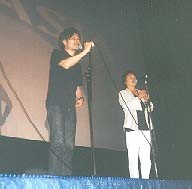
Kiyoshi Kurosawa Introduces Seance
Millenium Actress takes as its premise a documentary interview being conducted with Chiyoko Fujiwara, an elusive star of the Japanese cinema who withdrew from public life 30 years ago and lives now as a hermit in a small isolated house. Through her recounting of her life in film, the history of Japanese cinema comes alive. Kon uses Fujiwara’s recollections as the basis for a journey through times past, both the times of the actress’s career and even earlier ages of Japanese history that were portrayed in her films. The film slips in and out of time effortlessly, and brings the two documentarians conducting the interview along for the ride. Kon, who was a guest at the festival, warned us prior to the screening that we should not go to the bathroom after the movie starts as 200 years can pass in a second. Well, he was certainly right. The documentarians are whisked in whirlwind fashion through a myriad of times and places, and the film blends them all together into a seamless exploration of cinema and its impact on the life of a nation. The effect is very rhizomatic indeed, as the lines between past and present, fiction and reality, and youth and age are blurred to the point where they touch each other at all points.
The most prominent question that seems to be raised by the film is: “why is this animated?” It is interesting that a film so profoundly dedicated to exploring and celebrating the history of cinema throughout the last century (complete with lovingly rendered period settings and film recreations), as well as the processes of filmmaking itself, should choose one of the most non-photorealistic of techniques as its basic aesthetic approach. What an amazing work the film would be if was done in live action. As I suggested earlier, however, it seems that what the fairly classical animation style offers Millenium Actress (compared with the absolutely stunning combination of digital and traditional animation found in Metropolis this year) is a layer of distance between the subject matter, filmmaking processes, and audience that allows a measure of reflection on the complex web of relationships that the film presents. The animation also offers less differentiation between the various periods and settings presented, thus creating more of a sense of holism throughout the work that might be absent in a live action rendering. However, I am also very aware that the extreme nature of the emotional response given to the film suggests that the general public does not find the animation to create a distance between them and the images they see, but rather allows for a very deep emotional connection with material. I understand this implicitly, because I too have been very moved by animated material in the past. Regardless of the audience’s capacity for connection with the film, however, I believe that the animation still creates an undeniable rift between the filmmaking practices at the heart of the work’s subject matter and the practices used to explore that matter. In the end, the film’s crowning achievement is definitely the way it treats the unfolding of a century as the mind treats memory: a whole entity fitted with hypertextual random access, allowing the drawing of elements from across its breadth into the simultaneity of lived experience. The animation’s distancing and unifying aesthetic lends itself to this approach very well.
As I mentioned in my mid-festival report, this year’s festival has been largely concerned with the themes of gaming and role-playing, computer-based or otherwise. The shifting between fantasy and reality that has been the subject of several video game related pieces this year also works well with the shifting space so prevalent in Millenium Actress. The defining piece on that score this year, however, is definitely Daniel Monzon’s Heart of the Warrior. No film could be better placed in this festival, and the audience seems to have agreed, awarding it the prize for best international film. I actually overheard a discussion in the hallway between two people who apparently met at last year’s Fantasia when one of them was in desperate need of a twenty-sided die and the other just happened to have one in his pocket. Taking as its basis the adventures of a young Dungeons and Dragons enthusiast who dreams of becoming the heroic character he takes as his role-playing identity, Heart of the Warrior certainly found some identification among the crowd. Monzon’s film slips in and out of the young Ramon Belda’s fantasies and realities with inspired ease. It becomes clear early on that the young gamer is a little less than all there. His fantasizing moves beyond his sleeping and gaming hours as the film progresses, culminating finally with his whole life being taken over by a quest that, in reality, is the stalking and attempted murder of a local political figure. I wonder how many dazed Fantasians find themselves in similar predicaments during times when no outlets are available for their otherworldly needs. Perhaps Fantasia could apply for government funding, citing their importance to the Medicare system by keeping dangerous fanatics off the streets and out of trouble for two and a half weeks each year. Someone should do up a cost/benefit analysis…
Heart of the Warrior, while not a masterpiece by any stretch of the imagination, is a really fun romp and remarkably well achieved for a first time director. The visual style is exactly what it needs to be, with amazing set pieces for the barbarian fantasy sequences and fluid transitions between Ramon’s various states of mental being. The performances were all quite wonderful, and Monzon’s direction and inspiration skillfully combines an obviously strong empathy for the gaming world with a keen sense of the relationships between real-life political intrigue and the fantasies spurned on by coming of age in a world that provides little support for those who do not wish to abide by its rules. Heart of the Warrior is far more satisfying a spectacle than your average Hollywood actioner. Lots of fun.
Another direct address to the gaming community was found in the medium length film Otaku from Montreal filmmaker Stéphane Morissette. Structured around the experiences of a super geek (which is a rough translation of the Japanese word which the film takes as its title) who designs virtual reality software for those seeking sexual gratification, Morissette’s film is tailor-made for Fantasia fans. The director himself introduced the film by saying he made it expressly for the Fantasia crowd, and said he intended to continue doing so. I consider that to be a good thing, because this is a very well crafted little film exploring the relationships with fantasy and technology that can arise in contemporary society.
Throughout the film, the main character’s fantasies are made manifest within the space of his apartment that also serves as his headquarters for software design. One of the more striking moments of the bleeding between fantasy and reality occurs when our geek friend, obsessed with his own obesity, consults an internet physician and comes to the conclusion that he has contracted a tape-worm. Losing a lot of weight very quickly, he finds himself suddenly in the position of being sexually attractive, and manages to seduce his lovely female neighbor. In a scene that is ambiguous in terms of the actuality of the events it portrays, our hero lays his lover down on the bed with a pair of headphones injecting some steady electronica beats into her ears. On the film’s soundtrack we hear these beats in muffled fashion, as though they are actually coming from a pair of headphones worn by someone else. As our hero goes down on his companion, extra-diegetic ambient sound textures wash over the soundtrack, mingling gently with the sound coming from the phones. As the woman’s pleasure increases, the intensity of the sound does also, until finally in an orgasmic burst she tears the headphones from her ears and the music contained therein blasts forth into the full spectrum of the soundtrack. The effect is wonderful.
Aside from my enjoyment of the music itself, created by noted electronic musician David Kristian, the treatment of sound in the context of this scene illustrates the fundamental subject matter of the film as a whole. The personal computer is by design a very isolationist piece of technology. Much has been made about the seemingly perfect match between pornography and the desktop computer, and the increasing losing of touch and distance from true interpersonal communication that both pornography and computer obsessions can bring about. Headphones are also designed for usage by a single person at a time, and have been one of the premiere technologies of isolation long before the current state of computer technologies was even imagined. In the scene described above, our hero’s quest for the perfect technological simulation of passion is melded with headphone technology and the search for physical connection with other human beings. The fact that the object of his fantasy is the woman next door, not a non-existent cyber-creation, is significant. His desire is to reach out to the world, but his insecurities lead him to attempt this reaching out through technological means. The fact that he is offering her pleasure without direct gratification on his own part might illustrate his desire to live vicariously through the pleasure of others, which also ties in with his work to create software that can provide such pleasure to his customers. The way the sound is presented in the scene compliments the private pleasure that the woman receives in the embrace of her lover’s fantasy. The mingling of the diegetic and extra-diegetic music suggests the simultaneous connection and separation of the man and woman in question, and the sudden bursting forth of her sonic experience as she reaches her climax points to the obsession with goal oriented sexual activities that is at the heart of so much pornographic material. As he succeeds in bringing her to the logical conclusion of their sexual connection, he is (as are we) allowed inside her space that was previously delineated by the music coming from the headphones.
So a complex layering of the interrelationships between fantasy/reality, personal/conjoined experience, and the technologies of isolation and communication join in this scene to suggest, ultimately, the note that the film ends on: our hero making physical love to his personal computer. For all its emphasis on virtual space, the computer itself is still a physical entity, and our hero’s quest is for the tangibility of material conjugation. So the next logical step for him is to remove himself from the unsatisfying space of his virtual creations, and get down to business with what actually exists in his very room. This ending also speaks volumes to the ever-increasing interest being shown in the materiality of digital technologies, a materiality explored thoroughly in much contemporary electronic music on the cutting-edge of which we find the film’s composer David Kristian. Morisette has fashioned a beautiful and very stylish look at the complexities of our relationship with technology. I very much look forward to what he will be offering next.
Role-playing also took on a more personal element this year as one of Fantasia’s own brothers got the chance to leave his mark on the festival by taking on the identity of one of the most beloved characters to grace the screens this year. During the Q + A session following Troma Films’ TheToxic Avenger IV: Citizen Toxie, undoubtedly the most spirited of the midnight events this year, the much-loved Imperial Cinema tech guy Daniel donned the infamous visage of the Toxic Avenger and fielded a few questions along side director Lloyd Kaufman and actress Heidi Sjursen. The film was great, to be sure, but what can one really say about it? It really needs to be seen to be believed. The Q + A was almost as good; I have actually never seen anything quite like it in my life. There’s nothing like seeing Daniel in that Toxie mask get asked what his favorite sandwich is to which, after some intense introspection on the subject, he replies: “sausage.” Or watching intently as he lurches quietly over to Heidi’s rear and raises his mop ominously up in the air behind her (perhaps with retaliation on his mind for Heidi’s earlier attack on him), only to have his diabolical plans ruined by a quick whisper in the ear from Moderator Mitch. Probably best to get Toxie out of the way, since Heidi herself is flouncing all over the stage like an inebriated rag-doll, shouting obscenities at the audience and making lewd gestures towards anyone who dares ask her a question. At one point she states that “You don’t wanna fuck with possessed chickens….Poultrygeist!!” A woman responds with “I dunno, do ya?” only to have Heidi shout back “Show yourself!” This little exchange ends with Toxie muttering the word “chicken” over in the corner and the woman in the audience asking for Heidi’s phone number. And she isn’t the only one with less than honorable intentions towards the illustrious star of the silver screen. After waiting with his hand raised for some time, a young gentleman with a Mohawk finally stands up, his hand pointing poignantly at the object of his desires, and asks in a very serious tone: “Do you want to go outside and smoke a joint?” Heidi responds by asking him to take his shirt off, which he can’t seem to bring himself to do, though he does climb up onto the stage and carry Heidi off in his arms. And thus ends this very educational information session that Lloyd Kaufman seems to have greatly enjoyed. As did I.
From the impressive Korean line-up this year, three more films stand out prominently. Barking Dogs Never Bite, The Isle, and JSA: Joint Security Area all illustrate beautifully the extremely high quality and diversity of filmmaking that we have been seeing from South Korea. For a film that features an aspiring professor who hates dogs to the point of hurling them off of high-rise rooftops, a janitor who collects dog carcasses for his suppertime soup needs, and a vagrant who repeatedly usurps (uslurps?) the aforementioned soup, the mood in Joon-ho Bong’s Barking Dogs Never Bite is not macabre. Instead it is a touching tale of personal relationships in the midst of the quotidian as well as a truly funny and uplifting work. The dog-hating PhD, stressed out by his wife’s pregnancy and the need to secure a reputable teaching position, lets loose his frustrations on a neighboring dog by throwing it off the top of his apartment complex. The event (amazingly rendered by director Bong) is witnessed by two adolescent girls who are in the midst of their own personal difficulties. As the story unfolds, the girls try to track down the perpetrator, and we are brought into the two very different worlds of an unhappy husband dealing with his domestic situation and two friends struggling to understand themselves in relation to one-another. The film ends somewhat ambiguously, showing the husband sitting in a darkened classroom preparing a slide-presentation for his students. Having secured a position at the university by bribing the necessary officials, he can now afford to support the child that will be entering his life shortly, as well as the dog his wife recently acquired. Is he happy? Then, as the credits roll, we watch the two teenage girls walking in the forest on a beautiful afternoon. Are they happy? Bong intelligently weaves his dog humour in and out of his exploration of the human condition, and as a director does so with style and flare. A very enjoyable film.
Ki-Duk Kim’s The Isle is less cheery. Revolving around the goings on of a little lake resort made up of small floating huts, Kim’s camera floats between the huts and their guests, carving up the space of the lake resort like so much sushi caught fresh from its waters. The film’s subject matter bothered more than a few, I believe, with its emphasis on the bizarre relationship that develops between one of the resort’s guests and the woman who acts as caretaker. As she regularly makes her way through the little floating village in her canoe, selling coffee, supplies, and her body, she begins to take her visits with one man more seriously. The first time she tries to express her feelings for him, he tries to force himself on her in a disturbing display of unprovoked sexual hostility. As their relationship develops, the odd dynamic between them yields such behaviors as the placing of multiple fish hooks down throats and into vaginal areas before jumping into the lake only to be reeled in by the lines attached. The innocent creatures of the lake are not exempt from the torture either; one particular fish is caught, its fleshy sides carved off, then released still living where beautiful underwater shots capture it swimming around without the bulk of its meat. It is hard to understand what all this is in aid of, though it seems clear that Kim’s interest is in the ways people choose to express themselves when faced with the lack of communication that is often typical in relationships.
The film is unmistakably beautiful, and its dubious intentions create a sense of mystery that I find quite appealing. The film’s final shots are striking. As a criminal investigation involving the main guest brings police to the resort, the woman and man strap a motor onto their floating hut and set sail for the middle of the lake, far from the proceedings left behind. Captured in a high angle long shot that emphasizes the wonderful lake and its forested surroundings, this image then gives way to the man swimming into a floating forest of tall grass into which he disappears. Finally, the woman is seen naked and submerged within the confines of a sunken canoe, resting in the stillness of the calm waters. There can indeed be beauty in horror, and I found Kim’s look at the off-kilter happenings on this lake nestled somewhere in central Korea to be continually engaging, surprising, and interesting to both observe and contemplate.
Chan-wook Park’s Joint Security Area is an amazingly polished look at the division between North and South Korea. The film’s events revolve around a shoot-out at a remote border outpost, resulting in the deaths of two North Koreans and the injury of a South Korean, the latter of which subsequently becomes the chief suspect in the affair. Back in the demilitarized zone of the Joint Security Area, investigators try to piece the events together to figure out what happened. The film is an intelligent exploration of the tensions between the two countries as it beautifully pieces together isolated episodes that led up to the shoot-out, fleshing out the sentiments of both sides in the process.
Midway through the film a tourist of the JSA points her camera at the Northern end of the complex and is greeted by a guard, his arm outstretched in the halt command position. She snaps a photo of that scene, Northern soldiers smiling behind the guard as they march up a flight of steps. The tour guide comments that, in the worst case scenario, the woman could be hanged for stepping too close to the Northern area. The film’s defining moment comes in the very last shot when we get to see the tourist’s picture. Park’s camera begins with a close-up of the guard’s surly (and aviatored) visage, then performs an amazing navigation through the photo almost as if it were in three-dimensional space. It approaches the smiling soldiers in the rear, then drops to the ground where it spins around to the left and comes out seemingly from behind the soldier’s outstretched arm, effectively demonstrating how the crossing of the border between the North and South sides of the JSA is made possible by the photographic image. This also explains why the guard was protecting his area from being photographed, and, on a more macrocosmic level, demonstrates the power of the photographic image when considering issues of security. This shot also illustrates wonderfully the tensions that exist between still and motion pictures, and bridges the two in a very skillful and philosophically poignant way. The stillness of the photograph’s space brought into motion by the camera’s panning strategies could be an analogy for the state of arrest that exists in the JSA and the two Koreas as a whole, and how they might be freed up by a simple change of perspective.
The photographic image is about perspective, and the film’s final shot illustrates Park’s keen sense of the way that such images can both freeze space and free it from the confines of its conventional boundaries. The power of images is quite clear to most of us, especially those who seek out film, television and other visual media on a regular basis. Images fulfill a certain basic human need. It is thought by many that the human mind thinks in images more than anything else, and thus we are constantly struggling between our linguistic forms of communication and our understanding of the world in visual terms. There is also a growing body of work suggesting that our visual understanding of the world is not solely a function of our eyes, but that other sensorial information can also be understood by the brain’s visual cortex. Filmmakers like Stan Brakhage have long been interested in exploring vision as understood by other parts of human experience than just the passing of light through the pupil, while theorists like Michel Chion try to think beyond the isolated delineation of our senses to a more holistic understanding of human functioning. This would explain why many of us are addicted to images, and why we feel them so profoundly beyond simple sight recognition.
Media culture has played to this basic human instinct and method of understanding with extremely effective results. The events of September 11th demonstrate to what level we are now almost a physical part of the images and technology we depend upon to fill our need for a visual understanding of the world, and to what extent we have or have not become desensitized to spectacle of epic proportions. It strikes me that, although the news footage of the attacks on the World Trade Center and the Pentagon is almost incomprehensible in terms of truly coming to grips with the level of destruction that took place, people have also responded extremely emotionally to what we have seen. I don’t for one minute believe that we have become so cold and sterilized a race of beings that the horror of images like that doesn’t register somewhere very deep within us. What is disturbing, however, is that many of us have a thirst for the feelings of horror that such images impart with such exacting power, and a film festival like Fantasia is definitely geared towards providing at least a little bit of that horror to its devoted fans. As I sat glued to my television for all of Tuesday and a good part of Wednesday, I wondered why I felt the need to view and review the devastation. I had similar wonderings as I became increasingly worn-out over the course of the festival’s three weeks. I actually contracted a flu bug of some kind after the first week yet forced myself to sit through films while I was drifting in and out of sleep (most notably being Ebola Virus, during the viewing of which I wondered if I hadn’t also contracted the dreaded Ebola…) What is it that brings me back time and again to sit and stare at a screen for hours and hours on end?
As the news carried on through Wednesday, new footage kept arriving from cameras that had captured the second plane crash and the collapsing towers from various different angles on the ground. By the time the 10 PM report came around on the CBC, they had assembled a fifteen-minute narrative recounting of the events of the previous day, mixing dramatizations with the documentary footage. When it came time to show the second plane crash, they had created a montage based on the basic visual language of Hollywood cinema: coverage. And then it hit me: coverage is what the news is all about. The shot/reverse shot is one of the basic tenets of the cinema that we have all come to understand implicitly in North American society, and it is no accident that the news on this continent strives towards the same elements. Top that with the fact that these attacks were clearly designed for the television watching community, and what we have is a cataclysmic event designed for consumption through visual media and formed into the dominant visual form of the culture in which that medium is most prevalent. In the extra edition of Time issued on Friday Sept. 14, Lance Morrow discusses the attack on the US in terms of its designs for contemporary image culture. With statements like “this was terrorism brought to near perfection as a dramatic form” and “never has the evil business had such production values,” Morrow puts his finger on the true nature of this attack as a made-for-television event. In the same edition of Time, Nancy Gibbs likens the event to a musical composition, “so many instruments, all in tune, playing perfectly together to create their desired effect.” It was indeed a very well orchestrated event, and brings into view the line that may be disappearing between entertainment and actuality when considering the production of images for the purposes of mass consumption. This line becomes even more blurred when we consider Gibbs’ observation that the Microsoft Flight Simulator and Fly! II game software allows the gamer to practice flying between (or straight into) the towers of the World Trade Center. Our technologies of image creation and reception seem engineered for exactly this kind of event, and the attackers played it almost to a tee.
As Morrow says, “in an era of gaudy and gifted media, evil may vastly magnify its damage by the power of horrific images.” There is no doubt in my mind that the attack was designed for us, the viewers, and that regardless of whatever may result from it, the attackers have already had their victory: the image itself. Not one of us alive who watched the unfoldings on our televisions will ever be able to erase the images now etched indelibly on our minds. The power of these images exists as a function of our desire to watch them in the context of what we are used to seeing from the massive productions of Hollywood cinema. The extent to which we have brought this on ourselves is definitely something I believe we need to think about.
Of course I am very aware that North American culture is not the only one that craves spectacle, as an international festival like Fantasia clearly shows. Neither is our need for narrative unique, as storytelling is one of the oldest forms of communication known to humanity. It would be interesting, however, to look at what the differences might be between the ways different nations approach the creation of films for the purposes of inundating their audiences with high-level intensity. The subject requires too much depth to go into here, but I suggest that the popularity of this festival in the North American context might also suggest the level to which these films are made for export to our market. This would explain a lot about why Fantasia finds such a strong audience here, in the same part of the world where reality TV and the evening news provide extremely popular forms of screen watching.
For my final film discussion of this report I am going to be extremely unfair and drag a poor unsuspecting Chinese production into the foray surrounding North American media culture in the wake of last week’s attacks. Crash Landing, Mainland China’s answer to the Hollywood disaster blockbuster, proved to be an enjoyable epic at the time, but has now achieved a greater significance. As I sit in the theatre waiting for the lights to go down, I have no idea what I am about to see. When doing festivals to the extent that I did this one, I often like to go into a film knowing as little about it as possible so as to preserve as much of the element of surprise as possible. It is this element of surprise that works to create a sense of exhilaration in the viewing experience, and the news coverage of Sept. 11th surely had that going for it. As I realize that Crash Landing is indeed a plane crash film, I get quite excited. Nobody has been making plane crash movies lately, and as the film goes on it is clear that this is a spirited and successful attempt to capture the glory of on-screen air disaster in both humorous and serious ways.
What are most striking for me are the sequences in which various plane crash scenarios are imagined by the air traffic controller charged with the duty of trying to bring a malfunctioning plane safely to the ground. The fact that these images of destruction are simultaneously presented as a function of the controller’s imagination while being shown to us in the plain light of day is exemplary of the type of experiences I and others have had this past week. The images we saw on the news were very powerful, but they also created in our minds a whole host of imagined images that are sometimes even more horrific. In my case, for instance, I can no longer look at a tall building without seeing a giant gaping hole in it, or hearing the sound of an approaching plane. I also have difficulty shaking images I have of being aboard one of those planes. The sheer disbelief that must have been present as people looked out of their airplane windows to see the first tower already in flames and realize they were heading towards the second, or to see the Pentagon rushing up towards them at 600 miles per hour and realize that they were about to crash into the fortress of the American military. These images are as clear in my mind as the ones I’ve seen on TV, and Crash Landing‘s presentation of the psychological states of the fear and terror that accompany large-scale disaster seems very poignant at present. The film itself is not exactly a masterpiece, but its adherence to, and departure from, the Hollywood disaster genre makes it an interesting look at the horrendous possibilities that accompany technological development. A look we are all taking a little more seriously now.
So much of the rhetoric surrounding the attacks on the US focus on the need to get back to business, to show the perpetrators that they cannot crush the American spirit or way of life. A huge part of that way of life is based on the entertainment industry. One of Mayor Giuliani’s major efforts in the rehabilitation efforts for New York was to order Broadway back to work. So much of American culture is based on the state of the country’s entertainment, and I dare say that Canadians are not much different. I will be back for next year’s Fantasia festival no doubt, and before then I will have inundated myself to the saturation point at various other festivals around town. I’m now more aware of my own need for the consumption of images, and am questioning it more heavily than in I have in the past. However, it seems that North America could be identified by the slogan “The Show Must Go On.” And so it will. Until next time: happy viewing.
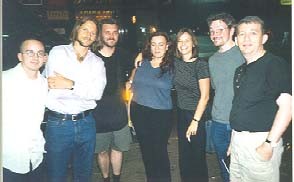
Yes they will be back next year



